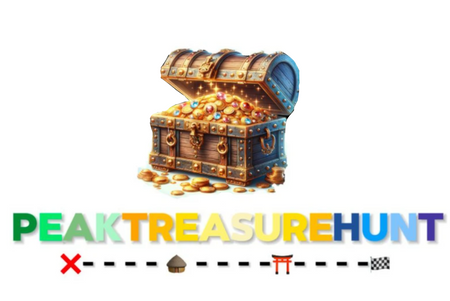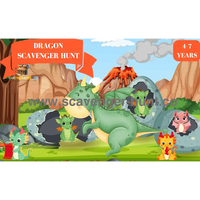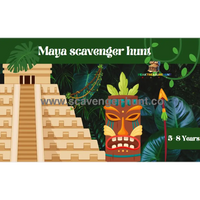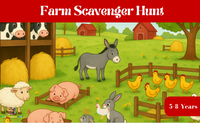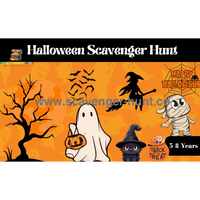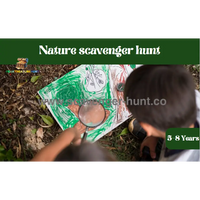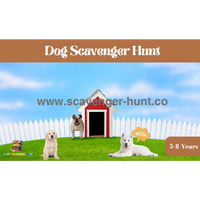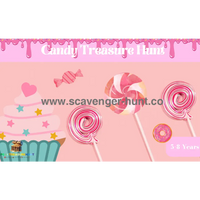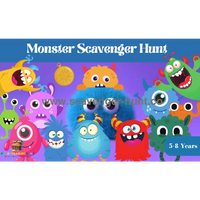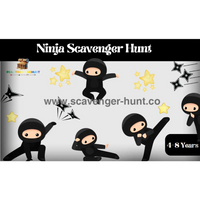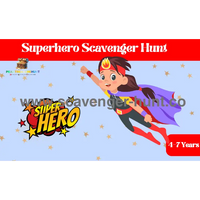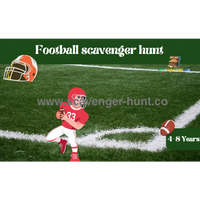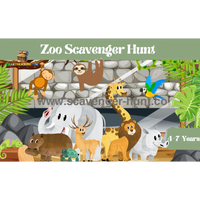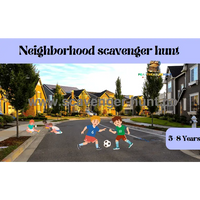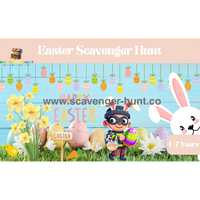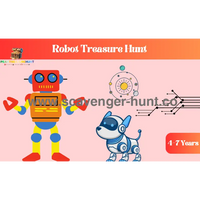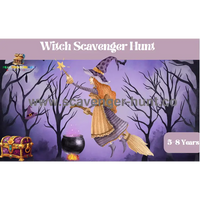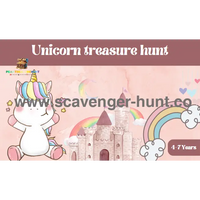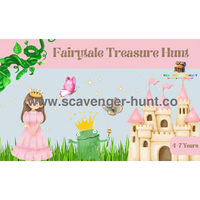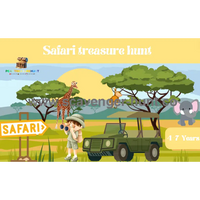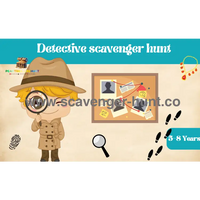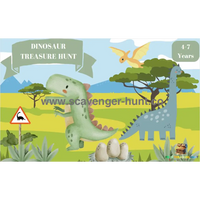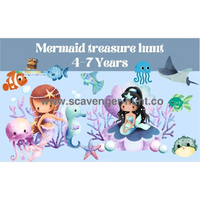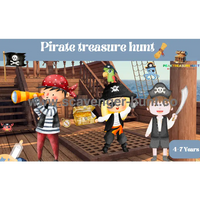🙌Exciting Scavenger Hunts for 6-Year-Olds: Fun and Learning Combined
Scavenger hunts are an excellent way to engage 6-year-olds in fun, educational activities that stimulate their minds and bodies. These adventures provide a wonderful opportunity for children to explore their surroundings, solve problems, and work together with friends or family. In this article, we will delve into various scavenger hunt ideas tailored for 6-year-olds, highlighting how these activities can be both entertaining and educational. Whether you're planning an indoor rainy day activity or an outdoor adventure in the park, these scavenger hunts are designed to keep young minds active and excited.
Classic Indoor Scavenger Hunts
Indoor scavenger hunts are perfect for rainy days or when you want to keep the fun contained within the home. These hunts are not only entertaining but also educational, helping children develop various skills such as observation, color recognition, and letter recognition. Below are some creative ideas for classic indoor scavenger hunts that will keep your kids engaged and learning.
Color Hunt
Objective: Find objects of a specific color around the house.
Instructions: Provide children with a list of colors and ask them to find items around the house that match each color. For example, they might need to find something red, blue, green, yellow, and so on. To make it more challenging, you can add shades of colors, like light blue or dark green.
-
Step 1: Create a colorful list. Write down the names of the colors or draw colored circles for younger children who are still learning to read.
-
Step 2: Explain the rules to the children. They need to search the house for objects that match the colors on their list.
-
Step 3: Set a timer if you want to add an element of urgency. This can make the game more exciting.
-
Step 4: Once the children have gathered their items, go through the list together to ensure they matched the colors correctly.
Learning Outcome: This hunt helps children recognize and differentiate between colors while enhancing their observational skills. It also encourages them to explore their environment and think creatively about the objects they find.
Alphabet Hunt
Objective: Find items that start with each letter of the alphabet.
Instructions: Create a list with the alphabet and ask children to find items around the house that start with each letter. For example, A for apple, B for book, C for cup, and so on. For younger children, you might focus on a smaller set of letters or use pictures alongside the letters.
-
Step 1: Prepare the alphabet list. Write out the alphabet in large, bold letters on a piece of paper or use printable alphabet cards.
-
Step 2: Explain the rules to the children. They need to find objects around the house that start with each letter on their list.
-
Step 3: To make the hunt more educational, discuss each item found. For example, talk about the letter sound, the item's use, or any interesting facts about it.
-
Step 4: For added fun, you can ask the children to put their found items in alphabetical order once they have completed the hunt.
Learning Outcome: This hunt promotes letter recognition and phonics skills. Children learn to associate letters with sounds and objects, which is a fundamental step in reading development. It also encourages them to think critically and make connections between different concepts.
Enhancing the Experience
To make these classic indoor scavenger hunts even more engaging, consider incorporating the following ideas:
-
Themes: Give your scavenger hunts a theme, such as animals, holidays, or favorite stories. This can add an extra layer of excitement and make the hunts more memorable.
-
Prizes: Offer small prizes or rewards for completing the hunt, such as stickers, extra playtime, or a special treat. This can motivate children to participate and do their best.
-
Team Play: If you have multiple children, divide them into teams and let them work together. This promotes teamwork and cooperative play, helping them develop social skills.
-
Creative Presentation: Use colorful paper, stickers, and markers to create visually appealing lists and instructions. This can make the activity feel more special and engaging.
Sample Activity Plan
Here’s a sample activity plan for an indoor scavenger hunt:
-
Preparation:
- Choose a scavenger hunt type (Color Hunt or Alphabet Hunt).
- Prepare the necessary materials (lists, markers, timer).
-
Introduction:
- Gather the children and explain the rules of the hunt.
- Show them the list and ensure they understand what they need to find.
-
Scavenger Hunt:
- Start the timer (if using one) and let the children begin their search.
- Provide encouragement and assistance as needed.
-
Review:
- Once the hunt is completed, gather the children and review their findings.
- Discuss the items found and the learning points (colors, letters, etc.).
-
Wrap-Up:
- Celebrate their success with a small reward or a group activity.
- Encourage them to share their favorite part of the hunt and what they learned.
Conclusion
Classic indoor scavenger hunts are a fantastic way to keep children entertained while also promoting learning and development. Whether it's identifying colors or recognizing letters, these activities are both fun and educational. By incorporating creativity and thematic elements, you can make each scavenger hunt a unique and memorable experience for your children. So next time you're looking for an engaging indoor activity, try one of these classic scavenger hunts and watch your kids learn and grow while having a blast!
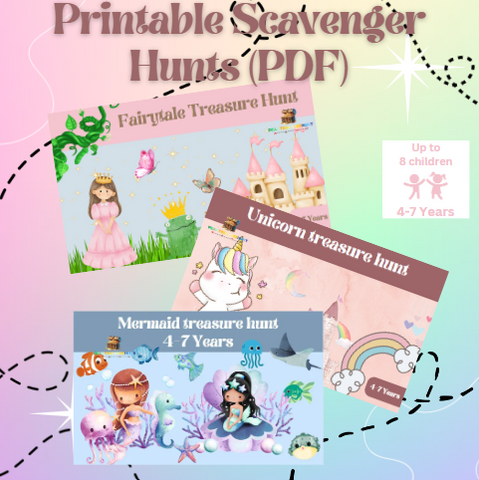

Outdoor Adventure Scavenger Hunts
Outdoor scavenger hunts are a fantastic way to combine physical activity with learning. These hunts encourage children to explore their surroundings, engage with nature, and develop a variety of skills such as observation, critical thinking, and spatial awareness. Here are some engaging outdoor hunt ideas that will provide hours of fun and education for kids.
Nature Scavenger Hunt
Objective: Find natural items such as leaves, rocks, flowers, and insects.
Instructions: Create a list of nature items for children to find in a park, backyard, or any outdoor space. Items can include different types of leaves, rocks, flowers, insects, and even specific tree barks. To add an educational twist, you can include items that are specific to your local ecosystem or ones that change with the seasons.
-
Step 1: Prepare a list of items. For example: maple leaf, smooth rock, yellow flower, butterfly, pinecone.
-
Step 2: Explain the rules. Children should search the designated area and find as many items on the list as they can.
-
Step 3: Equip the children with tools such as magnifying glasses, bags, or boxes to collect or observe items.
-
Step 4: Set a time limit for the hunt to add a sense of urgency and excitement.
Learning Outcome: This hunt teaches children about nature and the environment, enhancing their observational skills and knowledge of the natural world. They learn to identify various plants, animals, and other natural objects, fostering a deeper appreciation for the environment.
Shape Hunt
Objective: Find items of different shapes.
Instructions: Provide children with a list of shapes (circle, square, triangle, rectangle, etc.) and ask them to find objects that match these shapes outdoors. This can include natural objects as well as man-made items found in the outdoor space.
-
Step 1: Create a shape list. For instance: circle (round pebble), square (brick), triangle (leaf shape), rectangle (bench).
-
Step 2: Explain the rules. Children should look for objects that match the shapes on their list.
-
Step 3: Offer drawing materials. Encourage children to draw the objects they find that match each shape.
-
Step 4: Review the objects together. Discuss why each object fits a particular shape and how shapes appear in nature and in man-made structures.
Learning Outcome: This activity helps children recognize geometric shapes and apply this knowledge in real-world settings. It also enhances their spatial awareness and ability to identify and categorize different shapes.
Enhancing the Experience
To make outdoor scavenger hunts even more engaging, consider incorporating the following ideas:
-
Themes: Give your scavenger hunts a theme, such as "Forest Adventure," "Beachcomber Hunt," or "Urban Explorer." This can make the hunt more immersive and exciting.
-
Prizes: Offer small prizes or rewards for completing the hunt, such as a nature-themed sticker book, a magnifying glass, or a small potted plant. This can motivate children to participate enthusiastically.
-
Team Play: If you have multiple children, divide them into teams and let them work together. This promotes teamwork and cooperative play, helping them develop social skills.
-
Creative Presentation: Use colorful paper, stickers, and markers to create visually appealing lists and instructions. This can make the activity feel more special and engaging.
Sample Activity Plan
Here’s a sample activity plan for an outdoor scavenger hunt:
-
Preparation:
- Choose a scavenger hunt type (Nature Hunt or Shape Hunt).
- Prepare the necessary materials (lists, tools, markers).
-
Introduction:
- Gather the children and explain the rules of the hunt.
- Show them the list and ensure they understand what they need to find.
-
Scavenger Hunt:
- Start the hunt and let the children explore the designated area.
- Provide encouragement and assistance as needed.
-
Review:
- Once the hunt is completed, gather the children and review their findings.
- Discuss the items found and the learning points (nature facts, shapes, etc.).
-
Wrap-Up:
- Celebrate their success with a small reward or a group activity.
- Encourage them to share their favorite part of the hunt and what they learned.
Conclusion
Outdoor adventure scavenger hunts are an excellent way to combine fun with learning. By exploring their natural surroundings and engaging with different shapes and objects, children can develop a variety of important skills. These activities encourage them to observe closely, think critically, and appreciate the world around them. Whether you're searching for leaves and insects or identifying geometric shapes in nature, these scavenger hunts provide a dynamic and educational experience that kids will love. So next time you're looking for an outdoor activity, consider an adventure scavenger hunt and watch your children learn and grow while having a great time!


Themed Scavenger Hunts
Themed scavenger hunts add an extra layer of excitement by incorporating popular characters or stories that children love. These hunts can be tailored to different interests, making them a versatile and engaging activity for kids. Here are some fun themes that you can easily set up at home or outdoors:
Pirate Treasure Hunt
Objective: Find hidden "treasures" using a map and clues.
Instructions:
-
Create a Treasure Map: Design a simple treasure map with various locations marked. Each location should have a clue leading to the next spot, eventually leading to the treasure.
-
Prepare the Clues: Write clues that are age-appropriate and easy to understand. For example, "X marks the spot under the old oak tree," or "Find the next clue where the sun rises."
-
Hide the Treasures: Place small treasures (e.g., toy coins, candies, or small toys) at each location. The final location should have a bigger treasure or a special reward.
-
Explain the Rules: Gather the children, explain the rules of the hunt, and give them the first clue to start their adventure.
Learning Outcome: This hunt encourages problem-solving as children decipher clues, map reading as they follow the treasure map, and teamwork as they work together to find the hidden treasures. It also sparks their imagination as they embark on a pirate adventure.
Superhero Adventure
Objective: Complete tasks to "save the day" like a superhero.
Instructions:
-
Design Superhero Missions: Create a series of tasks that mimic superhero missions. For example, "Find the magical stone (a painted rock) to stop the villain," or "Collect the pieces of the superhero suit (cape, mask, gloves)."
-
Prepare the Tasks: Each task should be related to a superhero theme. For instance, finding items that represent superpowers like a red cape for strength or a flashlight for a "laser beam."
-
Set Up the Missions: Place the items or clues in various locations around your home or yard.
-
Explain the Missions: Brief the children on their superhero roles and the importance of completing their missions to save the day.
Learning Outcome: This activity promotes creativity as children imagine themselves as superheroes, role-playing as they act out their missions, and teamwork as they collaborate to complete their tasks. It also helps develop problem-solving skills and physical coordination.
Enhancing the Experience
To make themed scavenger hunts even more engaging, consider incorporating the following ideas:
-
Costumes: Encourage children to dress up according to the theme. Pirate hats, eye patches, and superhero capes can add to the fun and immersion.
-
Storytelling: Create a backstory for the scavenger hunt. For instance, explain that the pirates have buried treasure that needs to be found or that a superhero needs their help to save the city.
-
Challenges: Include physical challenges or puzzles in the hunt. For example, children might need to climb a small obstacle (safely) or solve a simple puzzle to get the next clue.
-
Rewards: Offer themed rewards at the end of the hunt, such as a pirate certificate, superhero badges, or small toys related to the theme.
Sample Activity Plan
Here’s a sample activity plan for a themed scavenger hunt:
-
Preparation:
- Choose a theme (Pirate Treasure Hunt or Superhero Adventure).
- Prepare the necessary materials (maps, clues, costumes, rewards).
-
Introduction:
- Gather the children and explain the theme and rules of the hunt.
- Distribute the first clue or mission.
-
Scavenger Hunt:
- Let the children embark on their themed adventure, providing assistance as needed.
- Encourage them to work together and use their creativity to solve clues and complete tasks.
-
Review:
- Once the hunt is completed, gather the children and review their adventure.
- Discuss the tasks they completed and the challenges they faced.
-
Wrap-Up:
- Celebrate their success with themed rewards and a small celebration.
- Encourage them to share their favorite parts of the hunt and what they learned.
Conclusion
Themed scavenger hunts provide a dynamic and engaging way for children to learn and play. By incorporating beloved characters and stories, these hunts capture children's imaginations and make learning fun. Whether they're hunting for pirate treasure or completing superhero missions, children will develop important skills such as problem-solving, teamwork, and creativity. So next time you're planning a fun activity, consider a themed scavenger hunt and watch your children embark on an adventure they'll never forget!


Educational Scavenger Hunts
Scavenger hunts are not only fun but also an excellent way to reinforce what children are learning in school. By turning educational content into a game, children can enjoy the learning process and retain information more effectively. Here are some engaging and educational scavenger hunt ideas designed to bolster your child’s academic skills while having a blast.
Math Hunt
Objective: Find items that correspond to different numbers or solve simple math problems.
Instructions:
-
Number Matching: Give children a list of numbers and ask them to find that many items. For example, "Find 3 red objects" or "Collect 5 leaves."
-
Math Problems: Write simple math problems that lead to the next clue. For example, "What is 2 + 3? Find the number of apples that match this sum," or "Solve 4 - 1 and look under the object that has this many legs."
-
Shapes and Sizes: Incorporate geometric concepts by asking children to find items of different shapes and sizes, such as "Find something shaped like a circle" or "Locate an object taller than your hand."
Learning Outcome: This hunt enhances various math skills, including counting, addition, subtraction, and understanding geometric shapes and sizes. It also encourages logical thinking and problem-solving.
Science Hunt
Objective: Discover items related to basic science concepts.
Instructions:
-
Nature Exploration: Provide a list of natural items to find, such as "Find a leaf," "Collect a rock," or "Discover an insect."
-
Physical Properties: Ask children to find items based on physical properties, like "Something that sinks," "Something that floats," or "An object that is magnetic."
-
Biology Basics: Include biological concepts by asking for items like "A living organism," "Something that grows," or "An example of a habitat (e.g., a bird's nest)."
-
Weather and Seasons: Integrate meteorological concepts by having them find "A cloud in the sky," "Something that indicates it is spring," or "An item that represents rain (e.g., an umbrella)."
Learning Outcome: This hunt helps children explore scientific principles and develop a curiosity about the natural world. It enhances their observation skills, encourages questioning and hypothesizing, and provides hands-on experience with basic science concepts.
Enhancing the Educational Experience
To maximize the educational value of these scavenger hunts, consider incorporating the following strategies:
-
Discussion: After each hunt, discuss what was found and how it relates to the lesson. Ask questions like "Why do you think this object sinks?" or "What did you learn about shapes today?"
-
Documentation: Have children document their findings by drawing pictures, writing short descriptions, or taking photos. This reinforces what they've learned and provides a record of their discoveries.
-
Challenge Levels: Adjust the difficulty of the hunts based on the child's age and skill level. Younger children might focus on simple counting and identification, while older children can tackle more complex problems and concepts.
Sample Activity Plan
Here’s a sample activity plan for an educational scavenger hunt:
-
Preparation:
- Choose the theme (Math Hunt or Science Hunt).
- Prepare the necessary materials (lists, math problems, science items).
-
Introduction:
- Gather the children and explain the theme and rules of the hunt.
- Distribute the first clue or list of items to find.
-
Scavenger Hunt:
- Let the children embark on their educational adventure, providing assistance as needed.
- Encourage them to think critically and ask questions about their findings.
-
Review:
- Once the hunt is completed, gather the children and review their discoveries.
- Discuss what they found, how they solved the problems, and what they learned.
-
Wrap-Up:
- Celebrate their success with a small reward or certificate.
- Encourage them to share their favorite parts of the hunt and what they found most interesting.
Conclusion
Educational scavenger hunts are a dynamic and engaging way to reinforce classroom learning while making education fun. Whether they’re solving math problems or exploring scientific concepts, children can enjoy a hands-on learning experience that stimulates their curiosity and critical thinking skills. By integrating academic content into playful activities, these hunts provide an effective and enjoyable way for children to learn and grow. So gather your materials, set up your hunt, and watch your children embark on an educational adventure they'll never forget!


Holiday and Seasonal Scavenger Hunts
Seasonal and holiday-themed scavenger hunts are a fantastic way to infuse festivities into playful activities. They offer unique opportunities for children to explore, learn, and celebrate the spirit of various holidays. Here are some creative ideas for holiday and seasonal scavenger hunts that will keep children engaged and excited.
Halloween Hunt
Objective: Find spooky items or complete Halloween-themed tasks.
Instructions:
-
Preparation: Gather Halloween-themed items such as black cat decorations, pumpkins, spider webs, skeletons, and ghost figurines. Write clues or descriptions for each item.
-
Setup: Hide the items around your house or yard. Ensure the hiding spots are age-appropriate, balancing between easy finds for younger children and slightly challenging locations for older kids.
-
Hunt: Give children a list of the items to find or provide them with clues leading to each spooky item. For example, "Find the ghost hiding where you brush your teeth" or "Look for the black cat near the place you sleep."
-
Tasks: Include themed tasks like "Perform a spooky dance" or "Tell a Halloween joke" to add an interactive element.
Learning Outcome: This hunt adds a fun twist to Halloween while encouraging creativity and enhancing observational skills. It also helps children develop problem-solving abilities as they decipher clues.
Easter Egg Hunt
Objective: Find hidden Easter eggs with clues or small prizes inside.
Instructions:
-
Preparation: Get plastic Easter eggs and fill them with small prizes, such as candies, toys, or written clues. Prepare a list of hiding spots.
-
Setup: Hide the eggs around your yard or house. The difficulty of the hiding spots should correspond to the children's ages.
-
Hunt: Provide children with clues to find the eggs. For example, "Find an egg where the flowers bloom" or "Look for an egg near something that swings."
-
Clues and Prizes: Incorporate educational clues inside the eggs, such as simple math problems or vocabulary words, that lead to the next egg or a grand prize.
Learning Outcome: This classic hunt promotes problem-solving and critical thinking. It adds excitement to the Easter holiday, encouraging children to engage in a fun and educational activity.
Christmas Treasure Hunt
Objective: Find holiday-themed items or complete festive tasks.
Instructions:
-
Preparation: Collect Christmas items like ornaments, candy canes, miniature reindeer, and Santa hats. Write clues or create a map for the treasure hunt.
-
Setup: Hide the items around your house or yard, ensuring they are well-distributed and moderately challenging to find.
-
Hunt: Provide children with a list of items to find or a treasure map with clues. For example, "Find the candy cane near the twinkling lights" or "Look for Santa's hat in a cozy place."
-
Tasks: Add festive tasks like "Sing a Christmas carol" or "Draw a picture of your favorite holiday memory" to make the hunt interactive.
Learning Outcome: This hunt helps children learn about Christmas traditions while fostering creativity and teamwork. It also enhances their ability to follow instructions and solve problems.
Summer Adventure Hunt
Objective: Discover items or complete tasks related to summer activities.
Instructions:
-
Preparation: Choose summer-related items like beach balls, sunglasses, shells, and ice cream cones. Write clues or create a list of items.
-
Setup: Hide the items around your yard, at a park, or during a family outing to the beach. Ensure hiding spots are safe and accessible.
-
Hunt: Provide children with clues to find the items. For example, "Find the sunglasses near the place you sunbathe" or "Look for the shell where the waves touch the shore."
-
Tasks: Include summer tasks like "Build a sandcastle" or "Find a cool spot and read a book" to make the hunt dynamic.
Learning Outcome: This hunt encourages outdoor exploration and physical activity. It also helps children learn about nature and develop observational skills.
Thanksgiving Gratitude Hunt
Objective: Find items or complete tasks related to thankfulness and gratitude.
Instructions:
-
Preparation: Choose items that symbolize gratitude, such as thank-you notes, pictures of family members, or leaves with positive words written on them. Write clues or create a gratitude list.
-
Setup: Hide the items around your home or yard. The hiding spots should encourage children to think about places or things they are thankful for.
-
Hunt: Provide children with clues that lead to each item. For example, "Find a note of thanks where you enjoy family meals" or "Look for a picture of your loved ones near a cozy spot."
-
Tasks: Include tasks like "Share something you are thankful for" or "Write a thank-you note to a family member" to incorporate the theme of gratitude.
Learning Outcome: This hunt helps children understand and express gratitude. It also encourages reflection on the things they appreciate in their lives, promoting emotional growth and mindfulness.
Conclusion
Holiday and seasonal scavenger hunts provide a fun and educational way for children to engage with festive themes while developing essential skills. Whether it's finding spooky Halloween decorations, hunting for Easter eggs, or exploring summer adventures, these activities offer a blend of excitement and learning. By incorporating themed tasks and clues, children can enhance their problem-solving abilities, creativity, and understanding of various holidays. So gather your materials, set up your hunt, and let the seasonal fun begin!


Frequently Asked Questions
What is a scavenger hunt?
A scavenger hunt is an engaging game where participants search for specific items or complete tasks based on a list of clues. It's a fun way to explore and learn.
How can scavenger hunts benefit my child?
Scavenger hunts can help children develop a range of skills, including observation, problem-solving, teamwork, and critical thinking. They also promote physical activity and can be tailored to reinforce educational concepts.
Are scavenger hunts suitable for children of all ages?
Yes, scavenger hunts can be adapted to suit children of all ages. For younger children, simpler clues and items can be used, while older children can handle more complex tasks and problem-solving challenges.
How can I create a scavenger hunt at home?
To create a scavenger hunt, decide on a theme or objective, make a list of items or tasks, and hide the items or set up the tasks around your home or yard. Provide clues or a map to guide the participants.
Where can I find more resources and ideas for scavenger hunts?
There are many online resources, books, and educational websites that offer creative ideas for scavenger hunts. You can also join parenting forums or social media groups to share ideas and find inspiration.
Conclusion
Scavenger hunts offer an exciting and educational way for 6-year-olds to engage with their surroundings, develop important skills, and have fun. Whether it's an indoor activity on a rainy day or an adventurous outdoor quest, scavenger hunts can be tailored to suit any environment and learning objective. By incorporating themes, educational elements, and seasonal fun, you can create memorable experiences that foster a love of exploration and learning in your child. So gather your clues, make your lists, and embark on the adventure of scavenger hunts for 6-year-olds!
Discover our Complete Scavenger Hunts Collection.




